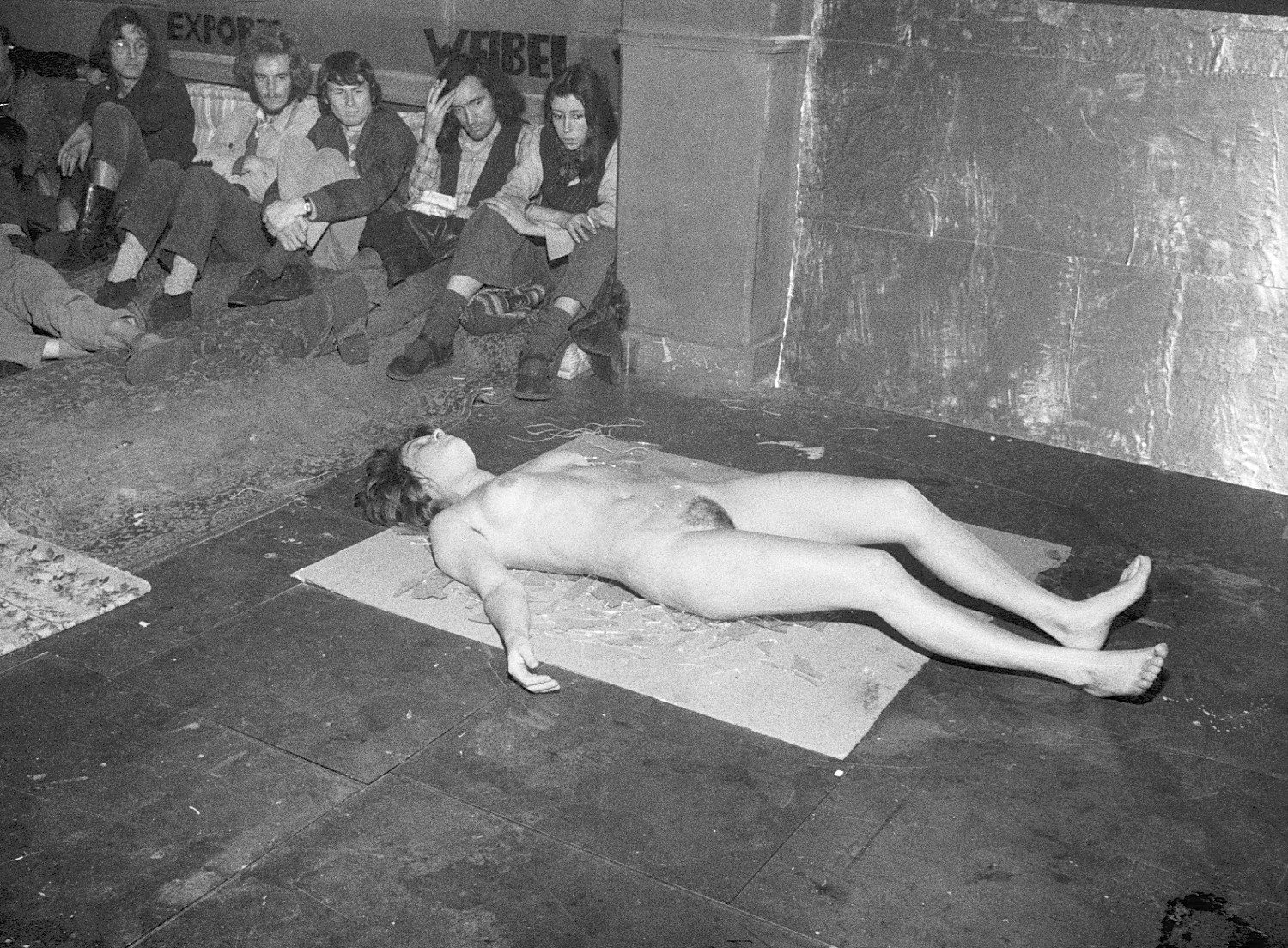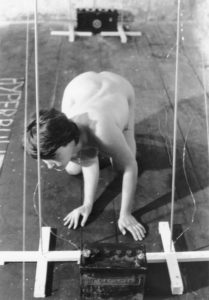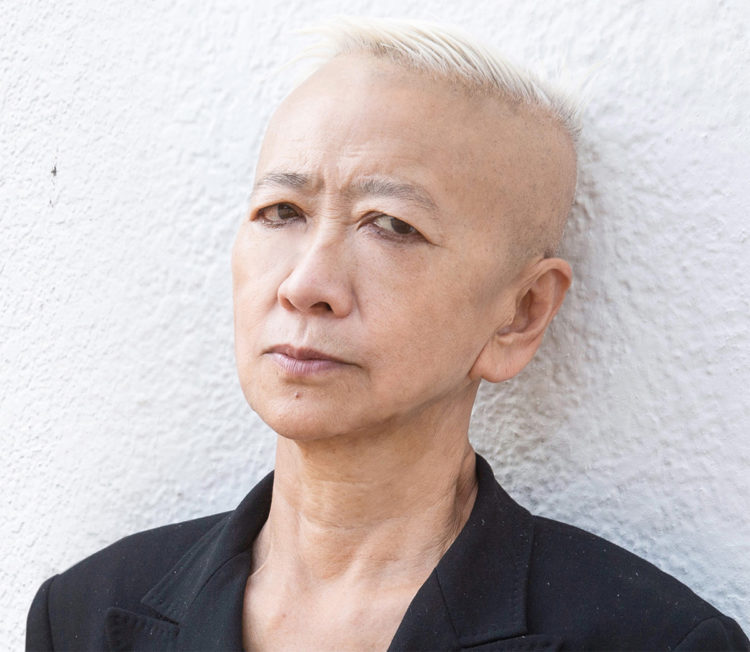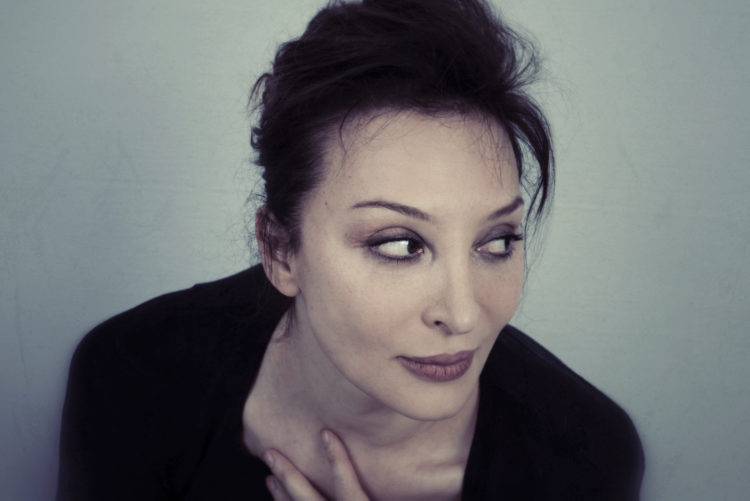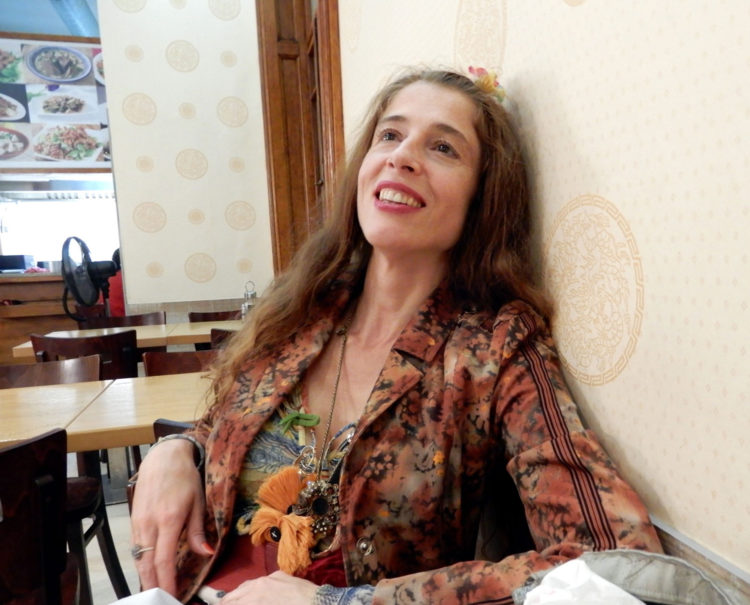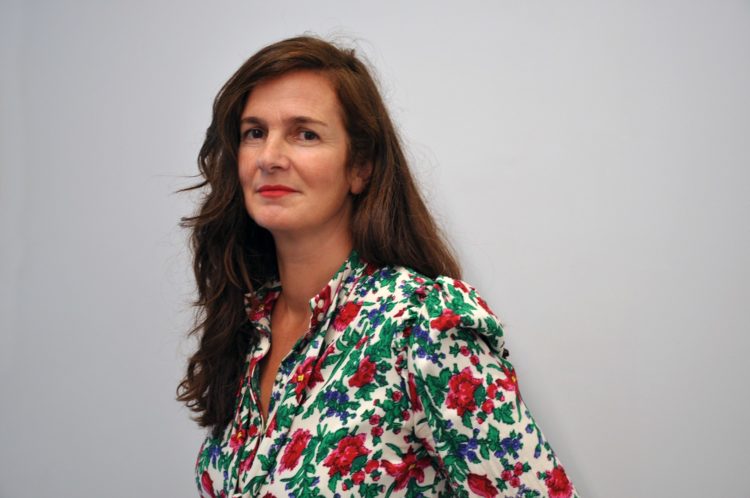Research
VALIE EXPORT is an artist, writer and filmmaker who re-mediated “actionism”, re-producing and fixing her performances as videos and films.1 In her manifesto, using the format as a feminist corrective to Direct Art, she writes: ‘Feminist Actionism seeks to transform the object of male natural history, the material “woman” subjugated and enslaved by the male creator, into an independent actor and creator, subject of her own history.’2 The primary source for feminist actionism is cited as the ‘history of female experience.’3
In VALIE EXPORT’s thesis, this history is not a psychology of the sexes, but rather refers to the forms of life produced through socialisation and education. Consider the then recent defeat in the home following World War II: the effects of fascism as a violent conservative retrenchment pressed onto daily life. Was this a battle that women lost, as others have posited, or was it merely a gain made by fascism, by masculinised authoritarianism and violence? What is the directionality of this? How is gender configured in VALIE EXPORT’s works? What kind of violence is played out?
Body Action
In Eros/ion (1971) VALIE EXPORT, nude, rolls across shards of glass, which make small incisions in her skin.4 She then rolls on paper, leaving the trace of this: images marked out by incisions. I’m interested in the space that is produced around this piece and in the trilogy of body actions also enacted in the early 1970s. We can say that in these spaces, VALIE EXPORT’s idea concerns pain: minor actual pain (and it is painful to watch) and the energy of resistance.5
In Hyperbulie, a performance filmed on video in 1973, we see a nude performer begin to navigate a boundary. Within a frame constructed from a corridor of wires discharging small electric shocks fed by battery power, she physically plots the route of the threaded wires, moving rhythmically, repetitively and lightly from side to side, continuously touching the wires with her face. The figure begins in an upright position, but after some time with this painful material, she gradually slumps to her knees before managing to escape through a manic or pathological act of will. Hyperbulie is a body-material action made as part of a trilogy. Before it came Kausalgie (a burning pain caused by an external, tactile, acoustic or optical stimulus) and after it, Asemie (the loss of the ability to understand or express signs or symbols, or the loss of mimetic communicability).
The live wires imply the constraining determinations of society. For VALIE EXPORT this piece therefore articulates the body as being marked or covered by the stigmata of the social matrix, turned into an un-toothed or tamed animal.6 The wires deplete the strength of the human trapped inside them. We are confronted with the human, reduced to her animality.7 Society closes in on the subject like a prison; the body becomes reified and deadened, merging with its constraints. Roswitha Mueller has argued that ‘[t]he wires signify those used to “pasture” c(h)attle.’8 Her (quite obvious) combining of the words cattle with chattel, point to the word play – the animal – indicating a form of property that, depending on the legal apparatus, referred to white bourgeois wives differently, to how it did to slaves. There is an obvious problem with any analogy between the form of property that bound white married women to their husbands and slaves to slave owners. It is unlikely that slaves understood their experience to be equivalent to white married women, or that the form of property can be understood to function on the same level, and therefore Mueller’s implicit pseudo-analogy only works in one direction.
VALIE EXPORT’s title Hyperbulie, “hyperbulia” in English, refers to a way of making many decisions at extreme high speed and from a state of neurosis. In the word hyperbulia, the prefix “hyper”, meaning to be excessive or exaggerated, is joined to abulia, referring to the ancient Greek boulêsis, which means something akin to what is now understood as “will”. When the prefix “a” is added, the word changes into its negative form, referring to the inhibition or pathology of the will, diminished motivation, or loss of drive. Though Mueller’s short description of Hyperbulie doesn’t seem strange or incorrect, there is more to be mined from it. Precisely from the discussion of how repetition and psychical paralysis, combined with volition and action, figure as a theme and a gesture tending towards excess, which is exemplary in VALIE EXPORT’s work, and in feminist actionism. How can we understand, then, the distinctions drawn between action, activity, Aktionismus, (busyness in the name of capital) and praxis in history? What can’t merely be willed? Is the escape within Hyperbulie a leap of faith? Or is it sacrifice – as every attempt to escape domination bears the potential to become a form of sacrifice? The person is caged/imprisoned, a reference which also speaks to the limits of the subject as a subject who can make the subjective claim to formal autonomy via their “free will” and capacity to choose. Here this is shown to be undone through an over-exertion of will. Can this artwork make a claim to objective autonomy?
Construction
If we leap forward in time, to the 1988 essay, “The Real and its Double: The Body,” VALIE EXPORT argues for a redefinition of the relationship of the body to its tools. Her strange claim is that the body can expand to incorporate objects (tools) into itself, thereby practicing a metonymical, or substitutive, relation between body and external object. The essay begins with a passage from Sigmund Freud’s pessimistic Civilisation and Its Discontents (1930):
With every tool man is perfecting his own organs, whether motor or sensory, or is removing the limits to their functioning. Motor power places gigantic forces at his disposal, which, like his muscles, he can employ in any direction; thanks to ships and aircrafts neither water nor air can hinder his movements, be means of spectacles he corrects defects in the lens of his own eye; by means of the telescope he sees into the far distance; and by means of the microscope he overcomes the limits of visibility set by the structure of his retina. In the photographic camera he has created an instrument which retains the fleeting visual impressions, just as the gramophone disc retains the equally fleeting auditory ones; both are at bottom materialisations of the power he possesses of recollection, his memory. With the help of the telephone he can hear at distances which would be respected as unattainable even in a fairy tale. Writing was in its origin the voice of an absent person; and the dwelling house was a substitute for the mother’s womb, the first lodging, for which in all likelihood man still longs, and in which he was safe and felt at ease.9
VALIE EXPORT appears to see in this passage from Freud a contribution to the development of a theory of media and technology at its intersection with the body. Freud’s suggestion that tools are indeed part of the expansion of the human body, revealing and confounding its limitations, is pertinent to the idea that tools can be both part of the natural organs and artificial prostheses. In her investigation of the meaning of the female body and its relation to reproduction (of capital and future labour) and reproductive technology (tools), VALIE EXPORT uses Freud’s text to de-naturalise the body’s capacity to reproduce human life and therefore to free woman from her imbrication in its sexed determinations. Tools are understood as “expansions,” “perfections” and “transgressions” of the human organism: we do not need to understand the human body as an entity fixed by biology.10
Furthermore, VALIE EXPORT’s analysis of the house deepens this investigation, as it ‘replaces the mother’s womb, not only because the embryo has become an adult, but because civilisation begins to replace and repress nature in the imposition of the reality principle.’11 Here VALIE EXPORT indicates the dialectical nature of this process: we cannot understand a simple notion of emancipation through our adaptation to, and adoption of, these technological tools, as they are also implicated in the subjugation and repression of peoples under the sign of ‘civilisation’. In this sense, VALIE EXPORT writes that ‘… [c]ulture […] also always means the civilisation of the body, the technical extension and expansion of the body.’12 VALIE EXPORT makes an unusual suggestion whereby, through culture and the development of the ego, the human body, having been penetrated by technological processes, also becomes external to the self; the body also becomes part of the external world, alienated from the subject. VALIE EXPORT writes that:
Via her body, woman becomes an element of the social grammar of masculine desire. Through the social grammar of the body, where the female set pieces such as breasts, belly, bottom, legs, and the like are interchangeable linguistic elements, the woman herself becomes interchangeable, obliterated, and in this sense doesn’t exist, as Lacan says. Precisely through reference to the body, to the female characteristics of the body (e.g., the womb as opposed to the phallus), woman surrenders herself for her own extinction in the patriarchal structure of our civilisation. […] Precisely because woman doesn’t exist, she must be constructed.13
This notion of construction comes about retroactively and is premised, ‘as Lacan says,’ on the idea that woman is crowded out by the symbolic. Furthermore, according to VALIE EXPORT, due to the ideology of femininity and how it operates, ‘[w]hoever presumes to be able to found her determination of Self on the feminine physical characteristics and sexual functions only deepens the masculine determination.’14 Here there are the two social determinants that construct the category “woman”, from its state of absence. They are: first, the cultural prosthetic-like quality of the body; and secondly, the gender determination of the body. Furthermore, in these sometimes conflicting ideas exploring gender and the body, the female body is the prime target of instrumental reason – as an object par excellence among objects of exchange. VALIE EXPORT asserts, with Freud and via culture, that the body is fully constructed through rationalisation and technological modernisation.
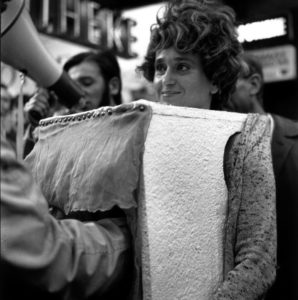
VALIE EXPORT, Tapp und Tastkino, 1968–71, performance, © VALIE EXPORT
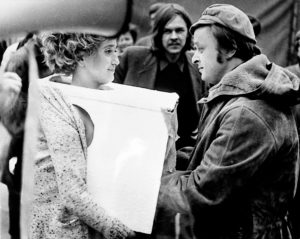
VALIE EXPORT, Tapp und Tastkino, 1968–71, performance, © VALIE EXPORT
Cinema Trap
In Tapp und Tastkino (1968-71) the performer wears a box that stands for a mini cinema, complete with a stage curtain, on her chest.15 Her collaborator, Peter Weibel, equipped with a megaphone, asks the consumer/public to enter the cinema with their hands. People are incited to touch the breasts inside the box. Meanwhile the wearer holds their eye contact: the gaze is returned. Tapp und Tastkino radically interrupts what Laura Mulvey would later characterise as the scopophilic gaze.16 Tast-, meaning touch, yields synonyms in German such as tactile [taktil] and groping [tastend], fumbling or tentative. The touch of the cinema should be a tentative, fumbling, groping touch. A touch that gropes in the dark while walking into a trap?
Often VALIE EXPORT’s own descriptions of the work oscillate between Film and Kino; the emphasis shifting ambiguously between the tactile film screen (the breasts) and the shrunken black box of the cinema; between the projection screen, the Leinwand becoming Hautleinwand, and the inhabited space. In her description of the film she writes, ‘[d]ie taktile Rezeption feit gegen den Betrug des Voyeurismus.’17 She argues that as long as the citizen [Bürger] is happy with a reproduced copy of sexual freedom [reproduzierte Kopie sexueller Freiheit], the state avoids, or is spared, a real sexual revolution.18 What kind of sexual revolution could overcome the state? What would a real sexual revolution look like? (Incidentally, a decade later, VALIE EXPORT marks a revision to her concept on female sexual self-determination, saying that it occurs at the expense of the woman “actionist”.)
The work Aktionshose: Genitalpanik was first performed in a Munich cinema and then produced as a series of posters, with VALIE EXPORT wearing jeans with the crotch cut out (the myth surrounding the work declares that during the performance she was carrying a gun).19 Silvia Eiblmayr described the dialectic of Aktionhose: Genitalpanik in terms of cutting the triangle out of the jeans, producing a positive image of female genitalia which confronts the audience with its negative, the ghost of castration anxiety (the obvious framing of this work lies in relation to Freud’s theory of castration anxiety, Panik, which produces “sexual difference”), in the form of the real body rather than its reproduced image.20 This is a form of assault. A weaponised body. The logic here, is akin to Tapp und Tastkino, insofar as these expanded cinema works directly focus on societal fetishes. They make an early attempt at a literal leap, suturing the questions of how the image of woman and “woman” are produced through cinema, advertising and pornography and, then, how this intersects with desire and fetishisation. The works critique the screen image by negating and transforming its material: the screen image is displaced by real breasts or by genitals. Freud’s prosthesis also reverses back onto the body. Mythic violence, as fateful, always returning and repeating, usually binding women to a certain role in the family, in society, is assaulted.
In VALIE EXPORT’s texts and works, there is an inquiry into the metaphysics and the transformation/“transfiguration” of the body and of “woman”: woman doesn’t exist and must be constructed. They also include a questioning of how “woman” is constructed. This is joined to an assertion of a metonymical substitution of body parts with tools. The extension and externalisation of the body, as I have shown in the example of Hyperbulie, where the body (of the performer is reified by constraints and) merges with its constraints. The constraints constitute the violent social apparatus – the border, civil society – which has always oppressed. The expanded cinema works show the displacement of the cinema qua culture industry, by fetishised, fixated body parts – breast and female genitals – as well as the critique of the consumption of images of women (woman as a sexual object).
In the text “Corpus More Geometrico” from 1987, VALIE EXPORT follows Maurice Merleau Ponty ‘Nicht einem physikalischen Gegenstand, sondern eher einem Kunstwerk ist der Leib zu vergleichen.’21 The body is transfigured from the realm of the object to that of the sign. Crucially for VALIE EXPORT, the body is not merely an instrument, but is simultaneously a body and its image. VALIE EXPORT uses the example of Leonardo’s Vitruvian Man to show how this body is stretched into a circle and a square simultaneously, becoming a wheel. It was this idea that she explored in her series of photographs Körper Konfigurationen (1976), in which her body is photographed using geometric shapes/angles in the situations of ‘house, city, country.’22 Here the body is exposed as something that is measured, as propelled by the force of measure. Yet, the photographic fixation points to the frozen history of culture, which is, for VALIE EXPORT, the history of silence over the body.23
In her words: ‘In der Metaphor des Körpers als Maschine verfällt der Körper einer grausamen Ökonomie und Funktionalität.’24
Rose-Anne Gush is a PhD candidate at the University of Leeds, where her project, provisionally titled Artistic Labour of the Body, explores the work of VALIE EXPORT and Elfriede Jelinek in conjunction with and against critical theories of art and aesthetics, feminism and psychoanalysis. She has written for various publications on art, photography, critical theory and feminism. She is currently living in Vienna.
Viennese actionism in its initial and prior form was known as “direct art” or “total art”. Actionism, a movement that severed itself from painting, was inaugurated in real-life, and aimed to act directly on reality, claiming immediate access to reality. The concept of “reality” was understood as merely what exists outside of the field of representation in art. In the 1960s actionism caused a social scandal, which, as Peter Weibel observed, ‘exploded when the naked body appeared in social space.’ In this newly figured social space, Viennese actionism (often with legal consequences) attempted to reconfigure this body in “reality”. Peter Weibel, in Malcolm Green, Brus, Muehl, Nitsch, Schwarzkogler: Writings of the Vienna Actionists (London: Atlas Press, 1999), p. 15.
2
VALIE EXPORT, “Aspects of Feminist Actionism”, New German Critique, No. 47, Spring-Summer 1989, pp. 69-92, p. 71.
3
Ibid.
4
Eros/ion was performed at Electric Cinema, Amsterdam, and the London Film-Makers’ Co-op, among other places.
5
“Feminist actionism” delves into the recent history of women engaged in this painful energy of resistance. It lays claim to different art movements, from Surrealism, which both ‘radicalised the image of women and darkened it by making it mythological’; to Art Informel, where Maria Lassnig’s introspective experience, expressed in her painting of the tension of the body, is then transferred to Simone Forti’s kinesthesia, body dances; to Niki de Saint Phalle’s sexually aggressive works, which still culminate in refusal. Early works by both Yayoi Kusama and Marina Abramović enter the tale, as well as some by Ann Halprin, Yvonne Rainer and Trisha Brown. For VALIE EXPORT, Mallarmé’s écriture corporelle is brought to its logical conclusion by being literally written onto the bodies of feminist Actionists, who, according to VALIE EXPORT, postulate their individuality against the dominant culture. Towards the end of the essay, in reference to her own action Tapp und Tastkino from 1968, VALIE EXPORT marks a revision to her concept of female sexual self-determination, saying that it occurs at the expense of the woman “actionist”.
6
VALIE EXPORT, archive text, Generali Foundation (1973). VALIE EXPORT writes: ‘so dass der Mensch – dessen Körper mit dem Stigmata der sozialen Matrix bedeckt ist – ein gezähmtes Tier wird’ (body is covered with the stigmata of the social matrix – turned into an un-toothed/tamed animal).
7
VALIE EXPORT, archive text. Generali Foundation (1973). “Gezähmtes” could be understood as a play on “gezähmt” (tamed), and “gezähnt” (toothed).
8
Mueller Roswitha, VALIE EXPORT: Fragments of the Imagination (Bloomington, Indianapolis: Indiana University Press, 1994), p. 41.
9
It is a paradoxical position that she takes, as this text is also one of Freud’s most pessimistic and reactionary with regards to the possibility of actual social change, while VALIE EXPORT uses it to point to conceptions of actual social change. Sigmund Freud, Complete Psychological Works of Sigmund Freud, Vol. 21, “The Future of an Illusion”, “Civilization and Its Discontents” and Other Works (London: Vintage Classics, 2001), p. 90.
10
VALIE EXPORT, “The Real and its Double: The Body” in Discourse, Vol. 11, No. 1, BODY // MASQUERADE, (Wayne State University Press: Fall-Winter, 1988-89) p. 4.
11
Ibid., p. 4.
12
Ibid., p. 5.
13
Ibid., p. 10
14
Ibid.
15
Tapp und Tastkino was enacted in Vienna, Munich, Cologne, Amsterdam, Breda, Eindhoven and London. The Cologne action differed, as VALIE EXPORT replaced Weibel on the megaphone and Erika Meis replaced VALIE EXPORT with the cinema box.
16
Mulvey theorised the ways that the ‘patriarchal unconscious has structured film form.’ Laura Mulvey, “Visual Pleasure and Narrative Cinema”, Visual and Other Pleasures, (Indiana University Press, 1989) p. 14. In VALIE EXPORT’s works, such as Cutting (1967-68), five distinct moments delineate phases, or parts, of cinema: ‘Part one: opening, a documentary; part two: a talkie, homage to Marshall McLuhan; part three: a comedy, homage to Bazooka Joe; part four: a silent movie, homage to Greta Garbo; part five: fellatio, public action. Body language.’ VALIE EXPORT, “Afflicting der Filme und Ordnungsbegriffe”, archive text, Generali Foundation.
17
(Tactile reception protects against the fraud of voyeurism.)
18
VALIE EXPORT, “Tapp und Tastfilm”, archive text, Generali Foundation.
19
One cannot write about this work without also acknowledging the “controversies” surrounding it. VALIE EXPORT has been cited as saying that she walked up and down the aisles of a porn cinema holding a machine gun, and rows of expectant viewers slowly walked out. She has also denied that she held a gun and has claimed that the action didn’t take place in a cinema. The myth around the work therefore persists as the work itself. Eiblmayr’s account contributes to this “controversy” insofar as her description is limited. In an essay titled “Actionmyth, History Panic: The entry of VALIE EXPORT’s Aktionhose: Genitalpanik into art history”, from 2014, Hilary Robinson aims to set the story straight. She attempts to uncover the “errors”, to write the true story of the artwork “as it happened”. Robinson investigates the work on the levels of chronology, medium, entrance into “history”, gesture and representation. Her argument states that the ‘lack of fidelity to the actuality of the artwork has shaped the disavowal of a feminist gesture of resistance to a conservative state and sexual politics’ (p. 85). Robinson’s reading of the work suggests that the “action” is in the occupation of a space where sexual and state politics meet one another. What does she mean by this? In her attempt at myth-busting, she raises the problem of ‘the image of a woman with a gun’, being one that is ‘easily fetishized and thus removed from a consideration of state politics and resistance’ (p. 87). But it is art. What do state politics mean to Robinson? She does not address the recent construction of the Austrian state in her essay, or the cultural politics propagated by that state. So, it remains unclear. Indeed, Robinson’s argument intends to show that the attempts at reperforming VALIE EXPORT’s works hollow out the politics that such works enact, rendering the works into images of politics. This is fine and a good enough critique. However, in my opinion, what is interesting in Aktionhose: Genitalpanik is the ambiguity that surrounds the work, the questions that can be raised through the idea of a woman parading female genitalia in a cinema. The work operates conceptually on this level no matter what we “really” know about how it “actually” happened, or what happened. In my reading, we must take these myths seriously to see how the mythic violence operates on a social level, to see how it is constructed and reproduced. Robinson’s argument falls into a trap of attempting to authenticate the work. It is more interesting to think of how this image of a woman with a gun and crotchless trousers gets turned into a fetish and an icon, than to merely “correct” this history. What are the mediations at play? The correction omits the stage at which these myths exist in society. Hilary Robinson, “Actionmyth, History Panic: The Entry of VALIE EXPORT’s Aktionhose: Genitalpanik into Art History”, n. paradoxa. Vol. 32, pp. 84-89.
20
Silvia Eiblmayr, “VALIE EXPORT’s Feminist Actionism in the Context of Performance and Body Art in the 1960s and 1970s”, in Allsopp, Ric and Scott deLahunta (Hrsg.) The Connected Body? An Interdisciplinary Approach to the Body and Performance (Amsterdam: 1996), p. 55.
21
In the German translation used by the artist: ‘Nicht einem physikalischen Gegenstand, sondern eher einem Kunstwerk ist der Leib zu vergleichen.’ (‘The body is not to be compared to a physical object, but rather to a work of art.’) VALIE EXPORT, “Corpus More Geometrico” in Marianne Pitzen, Self: Neue Selbstbildnisse von Frauen: Fotografien (Frauen Museum: Bonn, 1987).
22
‘Ich verwende die fotografische Fixierung in einem physikalischen Kontext (Haus, Stadt, Land) weil nicht die Bewegung des Körpers seine Bedeutung artikulieren soll, sondern ich den Körperkode aus gefrorenen Geschichte der Kultur, die eine Geschichte des Schweigens über den Körper ist, erzwingen.’ (I use photographic fixation in a physical context (house, city, country) because it is not the movement of the body that articulates its meaning, rather it is I who should force the bodily code out of the frozen history of culture, which is a history of silence over the body.) Ibid.
23
Ibid.
24
(In the metaphor of the body as a machine, the body falls victim to cruel economy and functionality.)
Rose-Anne Gush, "VALIE EXPORT: Image and Body Space." In Archives of Women Artists, Research and Exhibitions magazine, . URL : https://awarewomenartists.com/en/magazine/valie-export-image-espace-corps/. Accessed 17 July 2025
